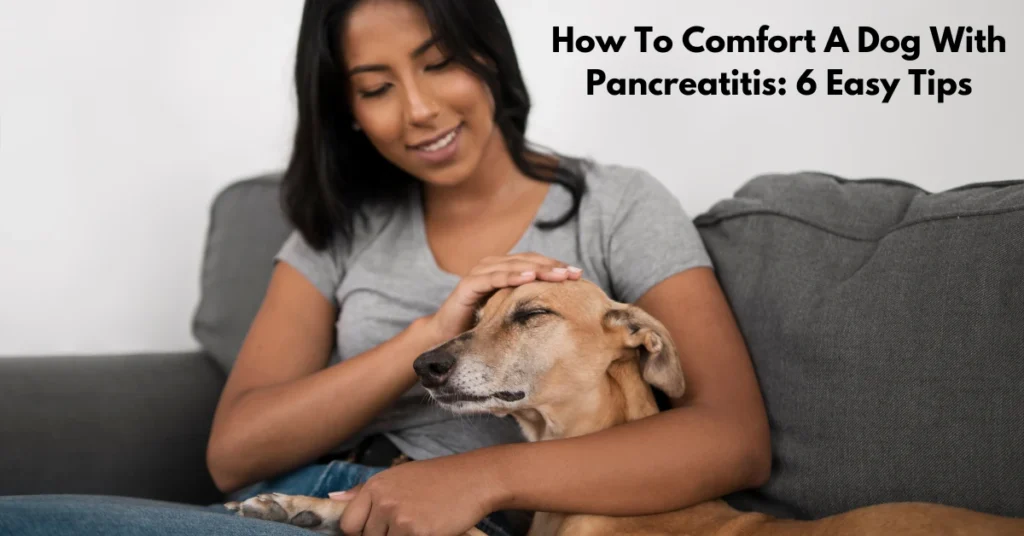Is your furry friend struggling with the pain and discomfort of pancreatitis? It’s heartbreaking to watch your dog suffer, but with the right care, you can bring them much-needed comfort. In this article, we will explore 6 easy tips to help soothe your dog’s symptoms and support their healing journey.
From diet adjustments to creating a calm environment, these practical steps will make a significant difference in their recovery. Let’s dive in and discover how you can provide the care and comfort your dog needs to feel better and wag their tail again.
Contents
Why Does Pancreatitis Happen To Dogs?
Pancreatitis in dogs occurs when the pancreas becomes inflamed, often due to digestive enzymes activating prematurely and damaging the organ. This can happen for a variety of reasons, including a high-fat diet, obesity, certain medications, or a sudden intake of fatty foods.

Other factors, such as a genetic predisposition, underlying medical conditions such as diabetes or hypothyroidism, and trauma to the pancreas, can also trigger pancreatitis.
In some cases, the exact cause remains unknown, but identifying risk factors can help pet owners take steps to prevent this painful condition in their furry companions. If you want to know more about pancreatitis then you can visit VCA Animal Hospital’s Pancreatitis Page
Signs Of Worsening Pancreatitis In Dogs
Symptoms of dog pancreatitis are important to know for proper treatment. Look here for the important signs of pancreatitis –
Increased Vomiting
Increased vomiting in dogs suffering from pancreatitis is a sign of severe inflammation, often resulting in repeated, sometimes continuous vomiting. This may also contain bile or blood. Vomiting increases dehydration and can lead to further complications, making it important to seek immediate veterinary care to prevent the condition from worsening.
Severe Abdominal Pain
Severe abdominal pain is a serious symptom in dogs with pancreatitis, often shown by a hunched posture, moaning, restlessness, or avoidance of touch. The pain can be intense, causing your dog to act upset or lethargic. Immediate veterinary attention is necessary to control the pain and prevent further complications.
Lethargy And Weakness
Lethargy and weakness in dogs suffering from pancreatitis are signs that the condition is worsening. Affected dogs may show a lack of energy, reluctance to move, or difficulty standing. They may also appear unusually tired or uninterested in activities they previously enjoyed. This lack of energy can be a sign of serious illness, which requires immediate consultation with a veterinarian.
Loss Of Appetite
Loss of appetite is a common sign of discomfort and illness in dogs suffering from pancreatitis. Affected dogs may refuse food or water, which can lead to dehydration and nutrient deficiencies. Refusal to eat can worsen their condition, requiring immediate veterinary care to manage symptoms and aid recovery.
Diarrhea
Diarrhea in dogs with pancreatitis is a sign of gastrointestinal discomfort caused by the inflammation. It may be watery, smelly, or contain blood. This symptom can lead to dehydration and further complications, which can worsen the dog’s condition. Immediate veterinary attention is necessary to control diarrhea and prevent more serious health problems.
Labored Breathing Or Panting
Labored Breathing or excessive panting in dogs with pancreatitis indicates severe pain or distress. This can result from abdominal pain, fever, or systemic inflammation affecting breathing. If your dog shows difficulty breathing or pants heavily without exertion, it signals a worsening condition and requires immediate veterinary intervention.
“If you consistently notice any of these symptoms then immediately consult with your veterinarian.” However, Some of these symptoms also occur in Cushing’s disease in dogs but you can consult with your doctor and understand the right treatment to prevent this.
How To Comfort A Dog With Pancreatitis: Learn 6 Easy Tips
Seeing a dog suffering from pancreatitis is heartbreaking and the owner gets worried after seeing his dog in such a condition and thinks of many questions.
- How to help a dog with pancreatitis
- How to comfort a dog with pancreatitis at home
- Treatment for pancreatitis in dogs
Don’t worry! At The Pet Guidance, you will know 6 easy tips to comfort your dog’s pancreatitis and somewhere these ways help to control the symptoms as well.
Provide A Bland Diet
For dogs suffering from pancreatitis, a bland diet includes low-fat, easy-to-digest foods such as boiled chicken, turkey, or lean ground beef mixed with plain white rice or mashed sweet potatoes. Avoid fatty foods and spices. This diet reduces stress on the pancreas, aids digestion, and promotes faster recovery.
Ensure Hydration
Ensure hydration by providing fresh clean water at all times for dogs with pancreatitis. Offer water frequently, as dehydration can worsen their condition. If your dog isn’t drinking enough, consider offering ice chips or an electrolyte solution recommended by your vet to maintain hydration and support recovery.
Create A Calm Environment
Create a calm environment for dogs suffering from pancreatitis by minimizing noise and stress. Provide a quiet, comfortable place where your dog can relax without disruption. Use soft bedding and avoid sudden changes or stressful situations. Gentle, soothing interactions can help your dog feel more secure and relaxed, aiding in their recovery and overall well-being.
Give Medications As Prescribed
Give the medications prescribed by your veterinarian for managing pancreatitis in dogs. Give the correct dosage at the specified time and complete the full course of treatment, even if your dog shows improvement. Proper medication helps control pain, inflammation, and digestive problems, aid recovery, and prevent complications. Always consult your veterinarian with any concerns.
Use Warm Compresses
Use of warm compress on your dog’s abdomen to ease the pain caused by pancreatitis. Apply a warm, not hot, compress for about 10-15 minutes several times a day. This can soothe discomfort and promote relaxation, but always make sure the compress is comfortably warm to avoid burning their sensitive skin.
Offer Gentle Physical Comfort
Provide physical comfort to dogs with pancreatitis by providing them with soft, comfortable bedding in a quiet place. Offer calm, soothing activities such as gently petting or brushing them to relax them. Avoid vigorous play or handling that may increase discomfort. This gentle approach helps your dog feel more secure and comfortable during their recovery.
“Such diseases cost a lot of money to the pet owners. Due to this, some people are not able to bear the full expenses of the dogs. In such a situation, taking the help of dog insurance is very useful. Therefore, every pet owner is advised to choose the right dog insurance plan to protect their pets and themselves.”
Treatment For Pancreatitis In Dogs
Dog pancreatitis treatment involves –
Fasting
Fasting is an important treatment for pancreatitis in dogs, allowing the pancreas to rest and reduce inflammation. During this period, your dog will not receive food or treats, only water. This approach helps reduce pancreatic enzyme production and promote healing which usually lasts 24 to 48 hours under veterinary supervision.
IV Fluids
IV fluids are crucial for dogs suffering from pancreatitis, helping to prevent dehydration and maintain electrolyte balance. Administered at the veterinary clinic, fluids support overall hydration, aid in flushing out toxins, and ensure adequate blood flow to vital organs. This treatment is typically combined with other treatments to help heal and stabilize your dog’s condition.
Medications
Medications for dogs suffering from pancreatitis include pain relievers to ease discomfort, anti-nausea medications to prevent vomiting, and anti-inflammatory medications to reduce swelling. Antibiotics may be prescribed if there is a risk of infection. Always administer medications as prescribed by your veterinarian to ensure effective treatment and avoid complications. Regular follow-up helps adjust treatment as needed.
Dietary Management
Dietary management for dogs with pancreatitis involves transitioning to a low-fat, easily digestible diet. This helps reduce pancreatic stress and supports healing. Foods like boiled chicken, lean meats, and prescription diets designed for pancreatic health are often recommended. Gradually reintroduce food to monitor tolerance and prevent flare-ups.
Monitoring
Monitoring is essential in treating pancreatitis in dogs. Regular veterinary check-ups track progress, assess response to treatment, and adjust medications or diet as needed. Blood test and imaging may be used to evaluate the pancreas and overall health. Ongoing observation helps ensure effective management and early detection of any complications.
Conclusion
With this informative knowledge, we understand how to help a dog with pancreatitis by understanding the symptoms of this. If you see that your dog’s condition is worsening day by day, then immediately take a step of consultation with the veterinarian, follow all the guidance, and give your dog a healthy environment to feel comfortable.
During these types of serious conditions, dog insurance plays a very important role which saves your money and gives your dog a healthy treatment.
Before buying a dog insurance plan you may know about
By understanding these dog life insurance plans you can cover most of the expenses of your dog even in pancreatitis disease. Save your furry friend’s life with the proper care!
FAQ – How To Comfort A Dog With Pancreatitis: 6 Easy Tips
What Toxins Cause Pancreatitis In Dogs?
Toxins that can cause pancreatitis in dogs include certain medications (such as corticosteroids), fatty human foods, pesticides, organophosphates, moldy foods, and the consumption of harmful substances such as xylitol, alcohol, or household cleaners.
Should I Put My Dog Down With Pancreatitis?
Euthanizing a dog suffering from pancreatitis is usually only considered if the condition is severe, chronic, untreatable, and causing extreme pain or poor quality of life. Always consult a veterinarian first to explore treatment options.
How To Comfort A Dog With Pancreatitis At Home?
To comfort a dog with pancreatitis at home, provide a quiet, comfortable resting space, feed small, low-fat meals, keep them hydrated, follow vet-prescribed pain management, avoid stress, and ensure regular vet check-ups.
How Long Does It Take For A Dog To Recover From Pancreatitis?
A dog can take a few days to several weeks to recover from pancreatitis, depending on the severity of the condition and response to treatment.
How Often Should I Feed My Dog With Pancreatitis?
Feed your dog with pancreatitis small, low-fat meals 3-4 times a day to avoid overloading the pancreas and aid digestion.

I’m Dr. Evan Antin, an animal expert and exotic animal veterinarian with a passion for helping pets and their owners thrive. With years of experience working with animals of all kinds, I bring a unique perspective to dog training, offering personalized in-home training sessions that cater to your dog’s specific needs. My goal is to create a strong bond between you and your pet through effective, compassionate techniques. Whether you’re dealing with behavioral issues or simply want to strengthen your dog’s skills, I’m here to help you achieve lasting, positive results.

